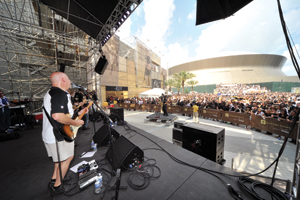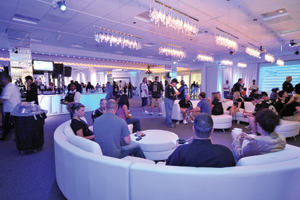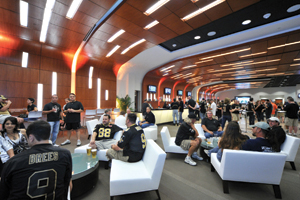Shortly before kickoff at the New Orleans Saints’ regular-season home opener, Stanley Rosenberg approached Doug Thornton on the floor of the Louisiana Superdome.
“We don’t have anything more to negotiate,” joked Rosenberg, longtime attorney for Saints owner Tom Benson. “I can sleep until 8 in the morning now.”
Thornton, senior vice president of stadiums and arenas for Superdome operator SMG, could only laugh.
 |
PAT GARIN PHOTOGRAPHY
The Saints and SMG have added music at Champions Square outside the Superdome.
|
Six years after Hurricane Katrina wrecked the Saints’ home, the dome sparkles inside and out after $336 million in restoration and renovations. Since 2006, those projects, paid for through a combination of Federal Emergency Management Agency funds, insurance dollars and state money, have put the premium spaces at the 36-year-old Superdome largely on par with MetLife Stadium and Cowboys Stadium, the two newest NFL facilities. The work includes two new bunker lounges, part of a complete overhaul of the stadium’s Plaza Level, the lower level.
As Rosenberg alluded, those clubs and other long-sought upgrades give the Saints a better chance to compete off the field in the NFL by adding the revenue-generating amenities that newer stadiums have in place.
The decision to rebuild an older stadium at less than half of the cost of a new building falls in line with facelifts at Arrowhead Stadium in Kansas City and Sun Life Stadium in Miami. Now, NFL teams have a third model to study for ideas to refresh their buildings and create new sources of revenue on a tight budget.
“What all of us have been able to do is turn this into a new stadium,” said Rita Benson LeBlanc, the Saints’ co-owner, executive vice president and Benson’s granddaughter. By squeezing those improvements in on a fixed budget, the Saints believe they have also developed “the most efficient new stadium in sports,” LeBlanc said.
The bunker lounges provide the wow factor on the premium end. The lower bowl was reconfigured and expanded by 3,400 seats in a stadium originally built for baseball, as well as football, concerts and trade shows. The new setup reflects a focus on football, said Dennis Lauscha, the Saints’ executive vice president and chief financial officer.
The Plaza Level concourse now stretches 50 feet wider in some spots. Fans sitting in the
 |
PAT GARIN PHOTOGRAPHY (2)
Seating in new bunker lounge (top) and Club 44 are some of the latest additions. |
upper levels are transported by new elevators and escalators.
New concession stands wired with digital TV screens keep fans connected to the game and can change prices for food and drink promotions and to display sponsors’ brands. All told, 273 new digital menu screens and concourse monitors dot the Plaza Level, part of a continuing effort to update technology inside the building. In doing so, SMG and the Saints developed an in-house system that saved them $400,000 over the $1 million-plus bids they received from third-party tech vendors, Thornton said.
Those enhancements, plus earlier projects to remodel suites and club rooms, build 15 more midlevel skyboxes after relocating the press box to the upper deck, and build a much bigger team store, were all part of architect Aecom’s 2002 master plan.
All those elements are critical pieces to a new revenue model to take pressure off the state of Louisiana. The state has given the small-market Saints millions of dollars over the past several years in inducements to help the team’s bottom line.
As part of a new lease signed in September 2009, a deal committing the Saints to play in the Superdome through the 2025 season, the state no longer is responsible for paying large sums to subsidize the team’s business operations. Under the old deal, the state paid the Saints several million dollars annually, including what would have been a $23.5 million payment in 2010. The new agreement greatly reduces the state’s financial burden. The ultimate goal is for the Saints to become self-sufficient.
Starting this season, the plaza level upgrades, plus stadium advertising and pouring rights the Saints took over from SMG, should lead to a $12 million boost to the team’s yearly bottom line. If the Saints reach that number by the end of 2011, the state does not pay the team a penny. Anything below $12 million, and the state signs a check for the team under a new formula in which the state’s contribution is capped at $6 million.
“There still is a safety net there, but I am fairly confident we will be able to self-generate enough money where it won’t cost the state anything … all because we have been able to build a better facility and sell that facility,” Lauscha said.
The Saints are off to a fast start. They have sold every ticket this season at a stadium that now seats 73,000, an increase of 1,000 seats over the old layout, and the new permanent concession stands and carts paid an early dividend: For the regular-season opener against the Bears, Superdome concessionaire Centerplate reported total food and beverage sales of close to $1.5 million, resulting in a $21.47 per cap. The gross number is a 21 percent increase over last season’s average, Thornton said.
The new bunker lounges support new inventory, 5,000 Plaza Club Sideline seats in the lower bowl’s three center sections. Those seats are priced at $298 a game, with food and drink in the lounge an additional cost. On top of that, Plaza Club patrons jumped at the chance to pay $350 for a reserved parking space in the Superdome garage, steps away from the lounges. All 1,000 parking passes reserved for the program were sold, said Mike Stanfield, the Saints’ vice president of ticket and suite sales.
“Now you can park 100 feet from the club, go into the club, then walk another 100 feet to your seat,” said Aecom principal Paul Griesemer, the architect for the Superdome upgrades. “Where else in the league can you be this close to your seat as a premium amenity? Here, you’re all indoors with covered parking.”
The bunker lounges, like the digital sign platform, were planned with efficiency in mind inside the 2 million-square-foot building, second in size only to Cowboys Stadium in the NFL.
The $85 million available for upgrades prevented officials from planning a pair of full-blown 10,000-square-foot destinations with high-end furnishings and carpeted floors. Instead, Aecom split each club into separate rooms. About 7,000 square feet of high-end space makes up the main club. On the other side of the wall, closest to the seating bowl, is 2,500 to 3,000 square feet of additional club space with fewer luxury finishes.
Those smaller areas, nicknamed “The Porch,” have a long bar, and tables and couch setups on a concrete floor surface. Behind both sidelines, The Porch carries some of the same high-end feel and gives fans a chance to grab a drink and run back to their seat. Plaza Club seat holders have access to both rooms.
The next big-ticket item is to install bigger video boards in both end zones, although there is no timetable for when that will happen, Thornton said. The current boards were installed in 2006.
Overall, the process is “like refurbishing a vintage automobile,” LeBlanc said. “There is a pricelessness to that so we don’t want to distract from the memories and the amazing historical events that have happened there.”






